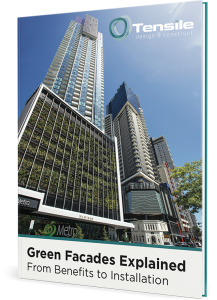Every green infrastructure project is unique, and will require an expert and bespoke solution.
This means a full analysis of both client expectations and the site’s characteristics will be necessary for getting the right ‘fit’ between the two.
Client expectations
The project starts with pinpointing what the client wants to achieve. Examples might include:
- An aesthetically-pleasing lush environment.
- Better shading, passive cooling and cost-savings on energy.
- Greater privacy, or covering up of an unsightly view.
- To create an environment that will attract more custom – such as for a shopping centre.
It can be a good idea to weight each aspect of the client’s goal to get a picture of what is most and least important. For instance, a low-cost solution might be one client’s primary goal, while another is more interested in a low maintenance structure.
It will of course be necessary to consider the budgetary constraints of the client in relation to the project. It’s also important to balance the client’s expectations with what is possible.
For example, the design a client likes might not work with the building itself, or the local environment. A client might be expecting plants to go up six stories from ground level, or grow to full height faster than nature intended!
Site assessments
The site itself will also dictate what is possible for a green infrastructure project, which is why a thorough site analysis is so important.
Factors that need to be considered include:
- Climate – including weather conditions, seasonal changes, range of temperatures, annual rainfall, and sun direction and so on.
- Structure – such as building height and size, load-bearing capacity, available space, wind forces, position of the building on site, overshadowing or light reflection from nearby buildings, and how sun and shade impact on the building.
- Site access – e.g. for machinery, equipment and materials for installation and maintenance. This will impact on the methodology used for installation of the structure, and what will suit one site may not suit another.
- Location of structure on the building – for example some plants require full sun and will not grow well on a south-facing wall.
- Aspects of the building – for instance in a project with several columns, there may be different elements that impact on each one, requiring a range of solutions across the one wall.
Real-world examples
- Warringah Mall – the emphasis in this project was on the plants, as the clients wanted a lush and green result. A site assessment showed there were a lot of micro-climates to consider on the site, as well as reflective light from other shop fronts.
- Advanx Apartments – with this project, there were council concerns regarding air-flow rates in the car parks and whether the plants would grow. The council imposed a condition on the developer mandating artwork be installed. Thanks to an understanding of the environment and the right mix of plants, the plants have now outgrown the artwork.
Site analysis is paramount to project success
At Tensile, we know that having a full understanding of site characteristics is necessary in order to deliver a successful project that meets client expectations.
Our green infrastructure projects start with an initial discussion to assess client goals, followed by a research and analysis phase, a design stage, and negotiation towards a final project solution. Contact us to get started!





































